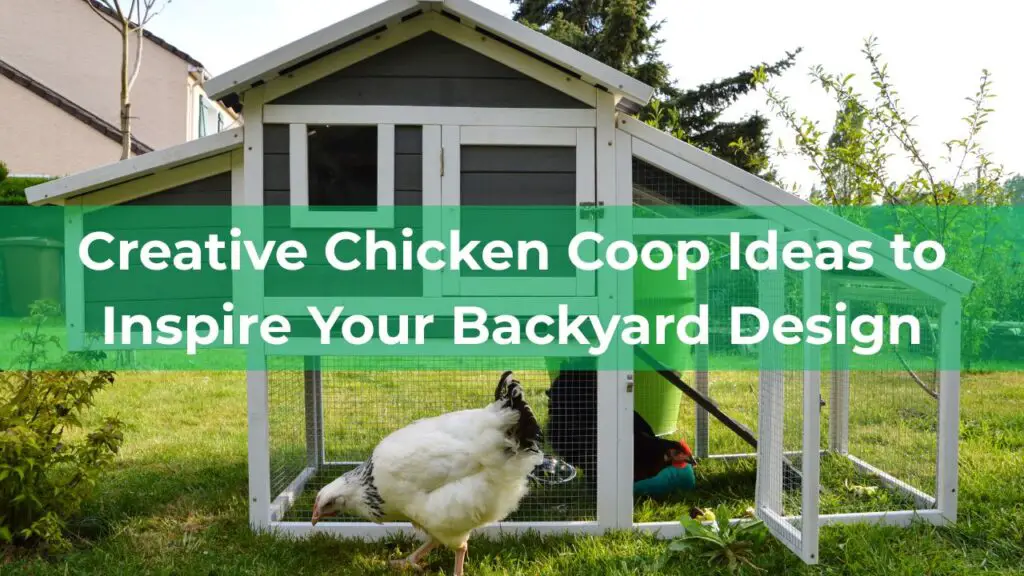Disclosure!
At The Daily Farming, your trust means everything. We use AI to help create some of our content, but every post is carefully reviewed and edited by real humans before it’s published.
Some of our images are AI-generated to help illustrate ideas, but everything you see is checked and approved by us.
Thanks for being here—we’re grateful for you!
We get it—those store-bought coops can cost a small fortune, especially when you’re just starting out. But here’s the good news: You don’t have to spend a ton to give your chickens a safe and comfy home. You can build your own chicken coop on the cheap, and no, you don’t need to be a pro carpenter to pull it off. A little creativity, some basic supplies (many of which you probably already have), and a weekend or two is all it takes.
In this post, we’re diving into 16 DIY chicken coop designs that won’t drain your wallet. Each one is budget-friendly and perfect for various backyard sizes—whether you’ve got a sprawling yard, a small garden, or something in between. We’ll cover the essentials: what to consider, what materials to use, how many chickens each design can hold, and how to keep your flock safe and happy.
And if you’re also thinking about building a budget-friendly DIY chicken run to go along with your new coop, we’ve got you covered. You can make a secure space for your chickens without spending a lot, just like your coop.
Plus, if you’re trying to figure out how to design your entire chicken setup alongside your garden, check out our guide on How to Design The Best Chicken Coop and Garden Layout Ideas. It’ll help you make your chicken coop and garden layout work in harmony, maximizing space and beauty.
So, roll up your sleeves and get ready to build something your chickens (and your wallet) will appreciate!
Why Build a DIY Chicken Coop Instead of Buying One?

While buying one might seem easier, going the DIY route has some serious perks—especially if you’re on a budget or love a good hands-on project.
Let’s break down why building your own chicken coop might be the better move.
Cost Comparison: DIY vs. Pre-Made Coops
Let’s talk numbers.
| Type of Coop | Average Cost | Notes |
| Pre-made (small) | $300–$700 | Often only fits 2–4 chickens |
| Pre-made (medium) | $800–$1,500 | Limited features for the price |
| Pre-made (large) | $2,000+ | Fancy, but pricey! |
| DIY (basic build) | $50–$150 | Using pallets, reclaimed wood, or old materials |
| DIY (mid-range) | $200–$400 | With store-bought lumber & hardware |
In short:
Buying a coop might save time, but it definitely costs more. With a little creativity, many folks build solid coops for under $100 using pallets, scrap wood, or leftover building supplies.
“I built my first coop using wood from an old deck I tore down. Spent less than $80 total, and it’s lasted 5 years!”
— Matt, backyard chicken keeper from Georgia
Plus, store-bought coops often cut corners. Flimsy materials. Too small. Poor ventilation. You’ll probably need to upgrade or modify it anyway—so why not start from scratch and build it right the first time?
Customization: Fit Your Space, Your Style, Your Flock
One-size-fits-all? Not with chickens.
Every backyard is different. Some are wide open, others have tight corners or sloped terrain. And every flock is unique—maybe you’ve got just three hens, or maybe you’re expanding to ten next spring. A DIY coop gives you total control.
With a homemade design, you can:
- Adjust the size for your space and flock size
- Add features like removable floors, windows, or built-in runs
- Choose materials that blend with your garden or yard style
- Make it mobile or stationary
- Include fun extras like a green roof or solar-powered lights
Think of it like designing a mini house for your chickens. You get to pick the layout, the color, even the little touches that make it feel special.
Tip: Chickens need at least 2–4 square feet of coop space per bird, and 8–10 square feet of run space. DIY lets you size it perfectly for your needs.
Satisfaction: That “I Built This” Moment
There’s something really rewarding about building something with your own two hands.
Sure, it might take a weekend (or two). You’ll measure things twice. You might even curse a few bent nails. But in the end? You’ll look at that finished coop and feel proud. And when you collect your first egg? It’s that much sweeter knowing you built their home from the ground up.
Also, DIY builds bring families together. If you’ve got kids, it’s a great way to teach them basic building skills and responsibility. Plus, chickens are way more fun when they’re living in something you made yourself.
And let’s be honest… you’ll probably want to show it off a little.
A coop you built becomes part of your story.
“Our coop started as a weekend project with my daughter. Three years later, the chickens are still happy, and we’ve upgraded it twice. Best decision we made.”
— Elena, suburban homesteader in Oregon
Need more ideas? Check out our 13 Creative Chicken Coop Ideas to Inspire Your Backyard Design and 17 Creative Small Chicken Coop Ideas for Your Backyard to spark your imagination!
What Makes a Good Chicken Coop Design?
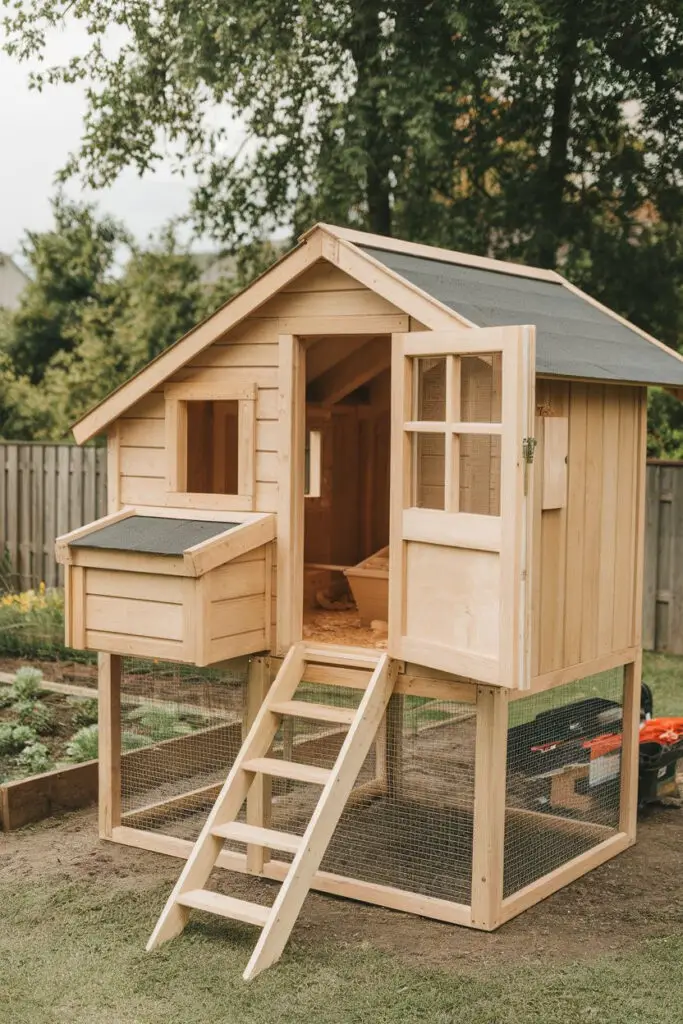
Building a chicken coop isn’t just about putting up four walls and a roof. Your hens need more than just shelter—they need safety, comfort, and enough space to live happy, healthy lives. So before you grab that hammer, let’s break down what makes a chicken coop design actually work—especially when you’re doing it DIY and on a budget.
Must-Have Features
No matter how simple or cheap your chicken coop design is, there are a few non-negotiables you have to include:
Ventilation
Fresh air is a big deal. Chickens produce moisture when they breathe (and poop!), and if that builds up, it can lead to mold, ammonia buildup, and respiratory problems.
- Add small windows, vents near the roof, or gaps under the eaves (covered with wire to keep pests out).
- Think cross ventilation—air should be able to flow through the coop, not just in one spot.
Good rule: If it smells bad to you, it’s already bothering your chickens.
Predator Protection
Raccoons, foxes, snakes, even neighbor dogs—everyone loves chicken dinner. Your coop has to be a fortress.
- Use ½-inch hardware cloth, not chicken wire (chicken wire keeps chickens in, but not predators out).
- Bury the wire 12 inches deep around the base to stop diggers.
- Lock all doors and latches tight. Raccoons are smarter than they look.
Roosting Bars
Chickens like to sleep off the ground. It keeps them warm, dry, and safe.
- Use a sturdy 2×4 laid flat (so they don’t hurt their feet).
- Place bars higher than nesting boxes to keep hens from sleeping where they lay eggs.
- One foot of roost space per chicken is plenty.
Related Article: Chicken Roost Ideas – Creative, Safe, and Comfortable Roosting Options for Your Flock!
Nesting Boxes
You want clean, easy-to-grab eggs—not a daily Easter egg hunt.
- One nesting box for every 3 to 4 hens is usually enough.
- Keep them lower than the roosting bars, in a dark, quiet corner.
- Add straw, shavings, or grass clippings for comfort.
Easy Access for Cleaning and Egg Collection
You’ll be in and out of the coop a lot—trust me. Design it so you can easily:
- Scoop poop without crawling on all fours
- Reach nesting boxes from the outside (hello, egg doors!)
- Refill food and water quickly
- Open up for full cleanouts once a month
Little details like a hinged roof or removable floor will save you hours of frustration later on.
How Much Space Do Chickens Need?
Chickens don’t ask for much—but cramped quarters lead to stress, fighting, and lower egg production. Not to mention a smell you won’t forget.
Indoor vs Outdoor Space Per Chicken
Here’s the general rule of thumb:
- Inside the coop:
- Minimum 2–4 square feet per chicken
- Go bigger if your flock will spend a lot of time indoors (like in winter)
- Minimum 2–4 square feet per chicken
- In the run (outdoor space):
- At least 8–10 square feet per chicken
- More is better—chickens love to scratch, peck, and dust bathe
- At least 8–10 square feet per chicken
Run Size and Height Considerations
- Chickens don’t love tight spaces. The more room they have, the less drama in the flock.
- If you’re not clipping wings, consider adding a roof or netting to prevent flyaways.
- Want to walk inside the run? Make it at least 6 feet tall. Otherwise, crouching becomes your new hobby.
Materials to Use for a Cheap DIY Coop
Building on a budget? Good. You’ve got options—and a lot of them are already sitting around in garages, barns, or Craigslist ads.
Reclaimed Wood
Great for rustic charm and saving cash.
- Use leftover fence boards, old barn wood, or even cabinet doors
- Watch for rot or nails sticking out
- Sand rough edges to keep chickens safe
Pallets
One of the best free materials out there.
- Look for heat-treated (HT) pallets—no chemicals
- Deconstruct or use whole for walls and framing
- Super durable and easy to find
Tip: Many local stores give pallets away. Just ask.
PVC Pipes
Lightweight, cheap, and surprisingly strong.
- Perfect for chicken tractors or portable runs
- Easy to cut and bend
- Combine with wire mesh and zip ties for a super budget-friendly frame
Plastic Barrels
Yes—barrels. They make great nesting boxes or mini coops.
- Cut in half lengthwise and mount inside the coop
- Easy to clean, waterproof, and predator-proof
- Check that they’re food-grade, not chemical barrels
Old Furniture
Think dressers, bookshelves, or cabinets.
- Turn a dresser into a nesting box station
- Use an old TV stand as a base for a mini coop
- Get creative—chickens don’t care if it once held socks
16 Chicken Coop Designs DIY Cheap (With Photos & Plans)
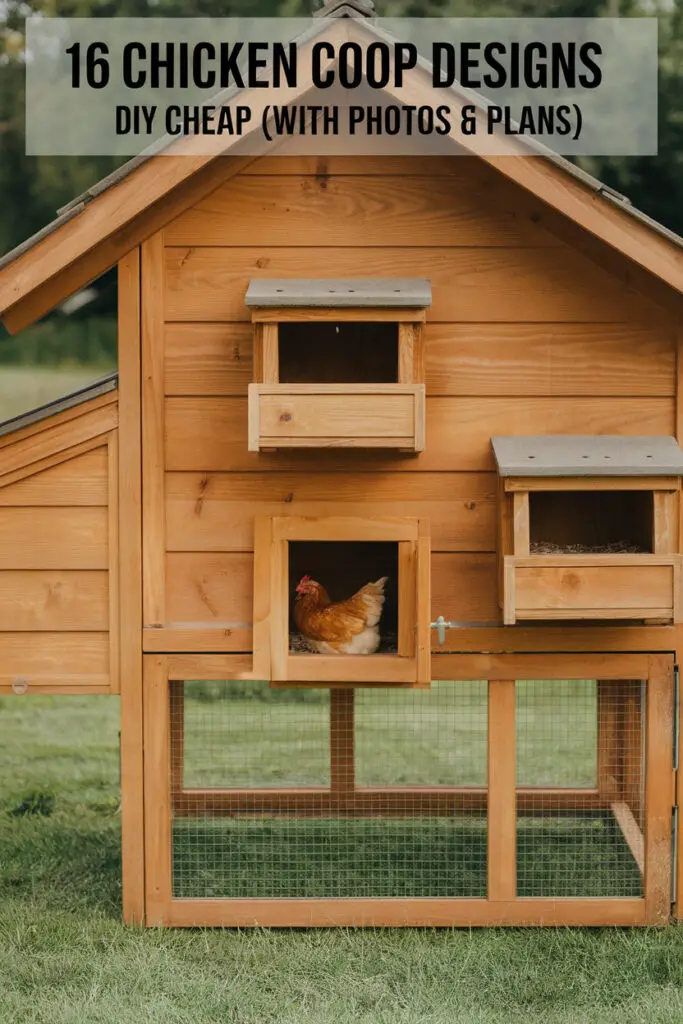
We’ll break down each DIY chicken coop design with everything you need to know: estimated cost, materials, how hard it is to build, and the pros and cons. These designs are perfect for backyard chicken keepers looking to save money while keeping their flock safe and cozy.
1. The Pallet Coop (Free-ish and Easy)
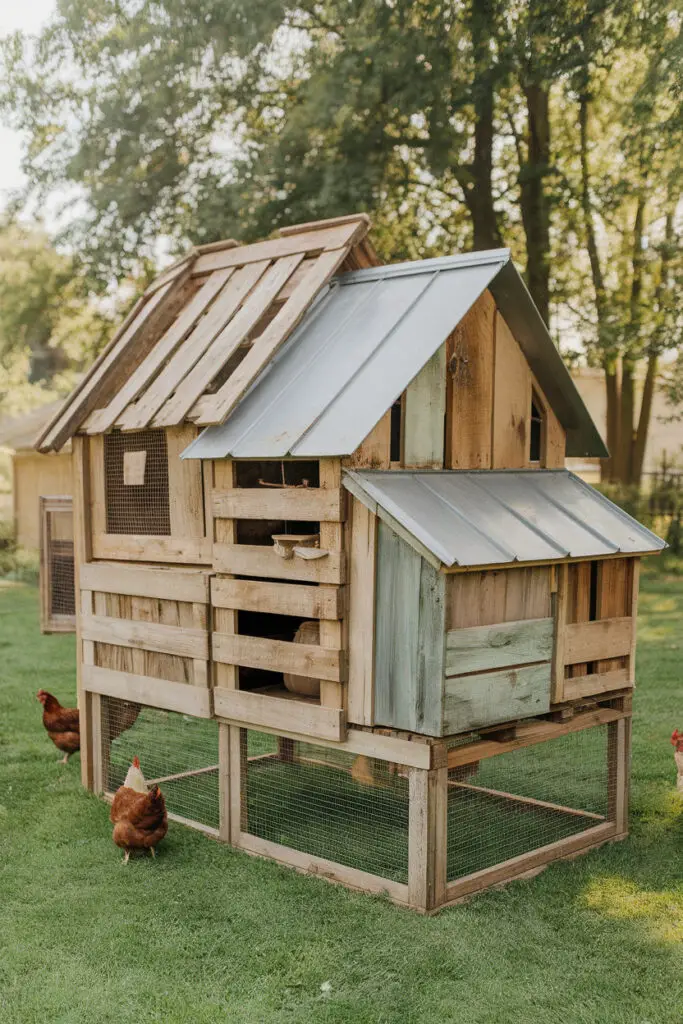
Estimated Cost: $0–$50
Materials: Wooden pallets, screws, hinges, tin or shingle roofing
Skill Level: Beginner to intermediate
Pros:
✅ Cheap or free materials
✅ Great for small flocks
✅ Rustic, country-style look
Cons:
❌ Can be heavy
❌ Takes time to break pallets down
Tip: Ask local stores or warehouses for free pallets. Make sure they’re heat-treated (look for “HT” stamp) and not chemically treated.
Here is a detailed guide on how to create a similar DIY Pallet Chicken Coop.
2. PVC Chicken Tractor (Lightweight & Mobile)
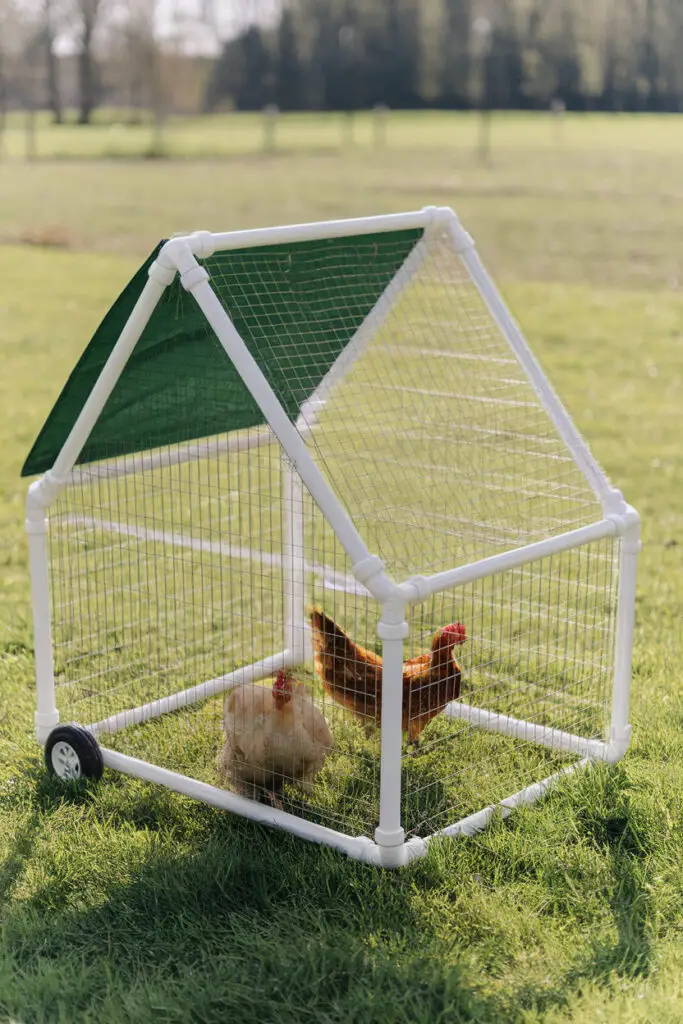
Estimated Cost: $50–$100
Materials: PVC pipes, chicken wire or hardware cloth, tarp, zip ties
Skill Level: Beginner
Pros:
✅ Lightweight and portable
✅ Great for rotating pastures
✅ Easy to build in a day
Cons:
❌ Not ideal for large flocks
❌ Less insulated in winter
Tip: Anchor it down in windy areas or add a wooden base for more stability.
Here is short video on how to make a similar PVC chicken tractor:
3. Converted Doghouse Coop
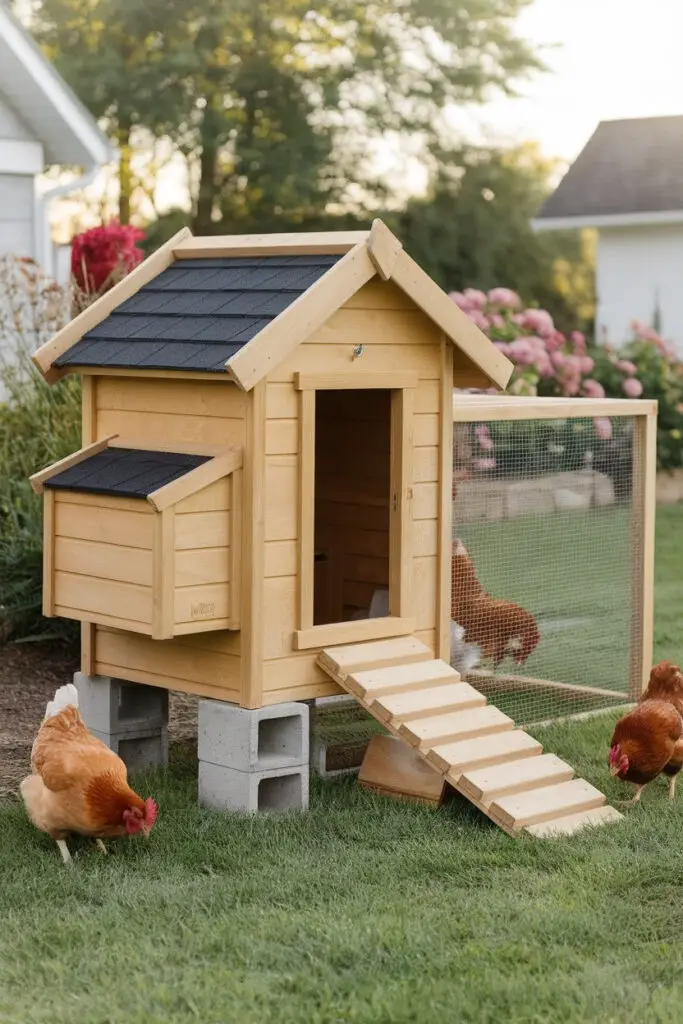
Estimated Cost: $30–$80
Materials: Old doghouse, roosting bar, nesting box, hardware cloth
Skill Level: Easy
Pros:
✅ Reuses something you may already have
✅ Perfect for 2–3 hens
✅ Compact and cozy
Cons:
❌ Limited space
❌ Must be predator-proofed
Tip: Raise it on cinder blocks and attach a small run to give chickens some extra roaming space.
Here is a quick guide on how to convert a dog house to a chicken coop.
4. A-Frame Chicken Coop (Simple & Stylish)
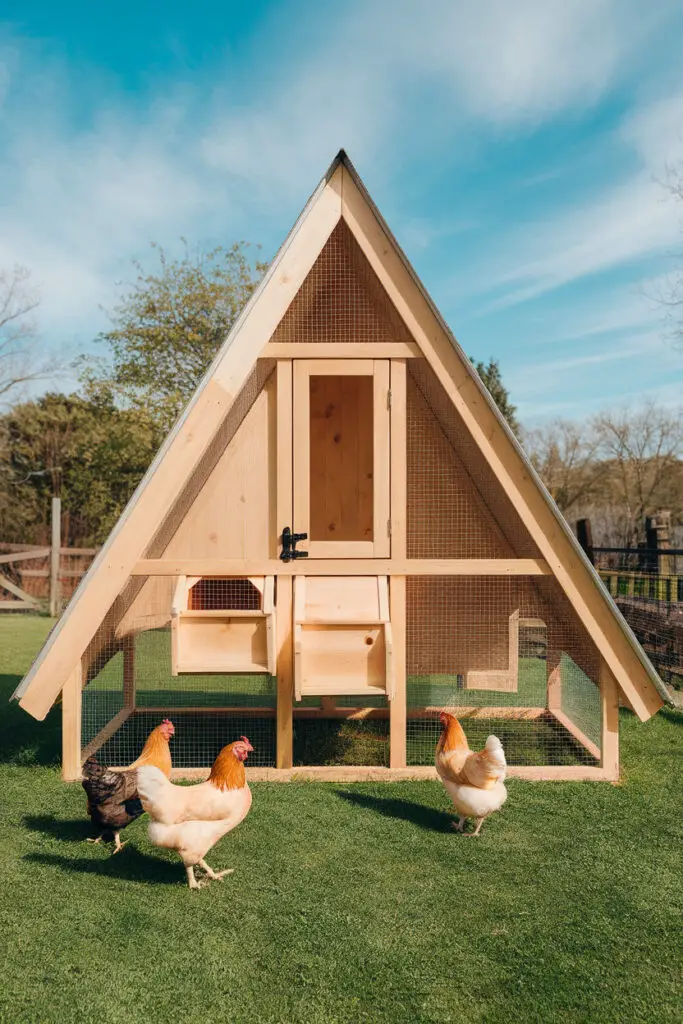
Estimated Cost: $100–$200
Materials: Lumber, plywood, hinges, roofing, wire mesh
Skill Level: Intermediate
Pros:
✅ Cute and compact
✅ Sloped roof sheds water
✅ Easy access
Cons:
❌ Limited space for more than 4 hens
❌ Interior headroom can be tight
Tip: Add a hinged roof section for easy cleaning and egg collection.
5. Recycled Shed Coop (Upcycling Win)
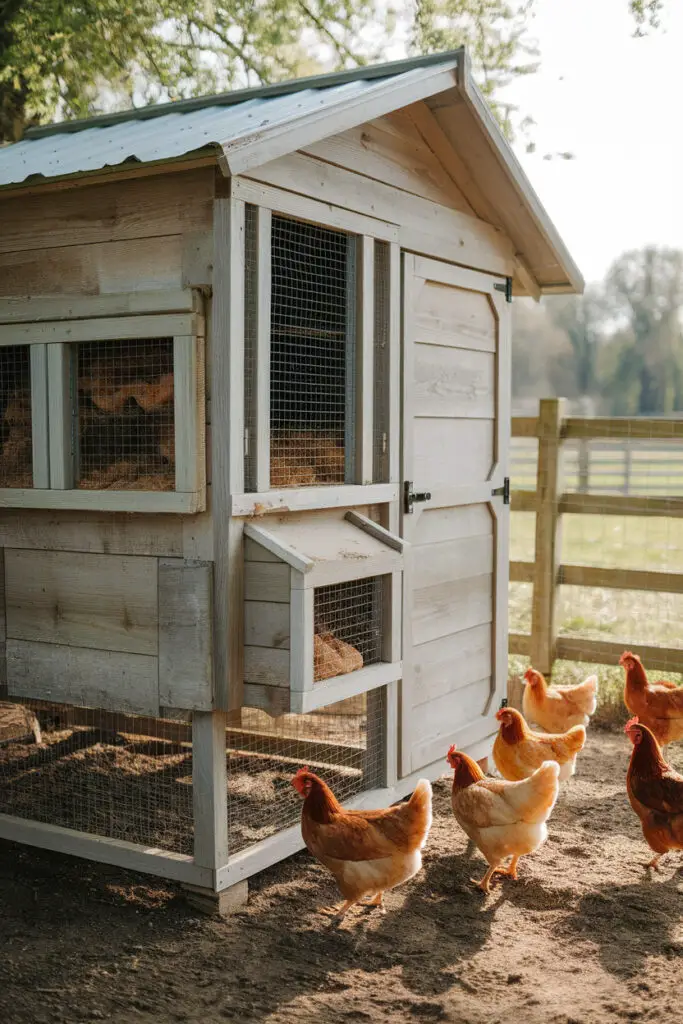
Estimated Cost: $100–$300
Materials: Old shed, nesting boxes, roosting bars, vents
Skill Level: Intermediate to advanced
Pros:
✅ Lots of room for large flocks
✅ Already weatherproof
✅ Long lifespan
Cons:
❌ Requires space
❌ Can take time to clean out and retrofit
Tip: Add a chicken run to one side and convert windows to vents for airflow.
6. Crate Stack Coop (Modular and Fun)
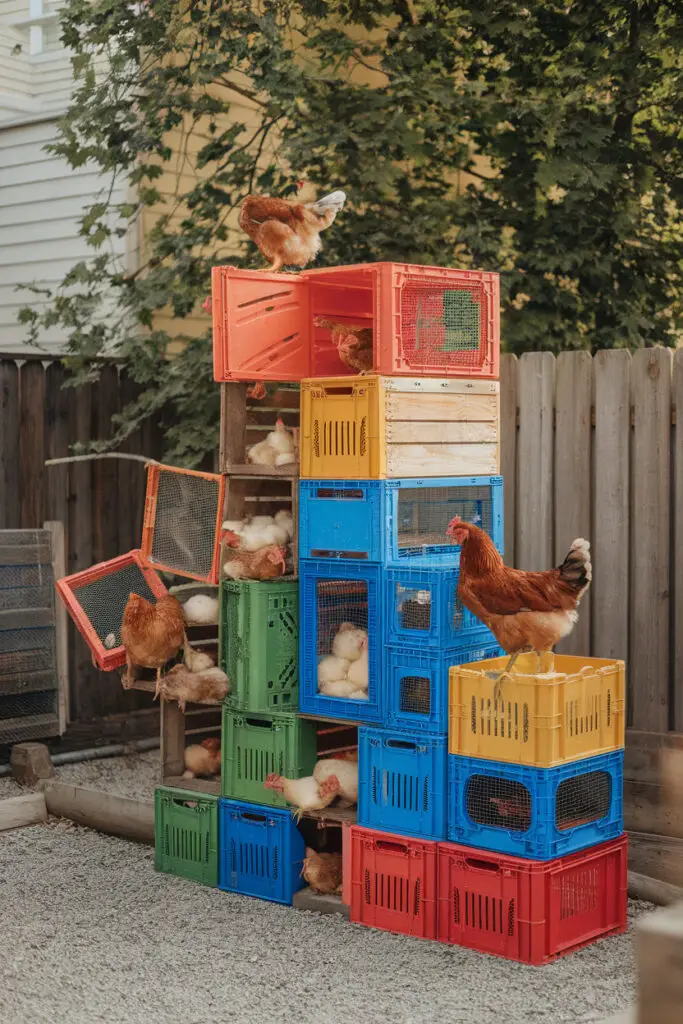
Estimated Cost: $20–$60
Materials: Plastic or wooden crates, zip ties, wire mesh
Skill Level: Beginner
Pros:
✅ Stackable and customizable
✅ Great for urban settings
✅ Easy to clean
Cons:
❌ Not for cold climates
❌ Limited predator protection unless reinforced
Tip: Stack three crates vertically: bottom for feeding, middle for nesting, top for roosting.
7. The Hoop House Coop
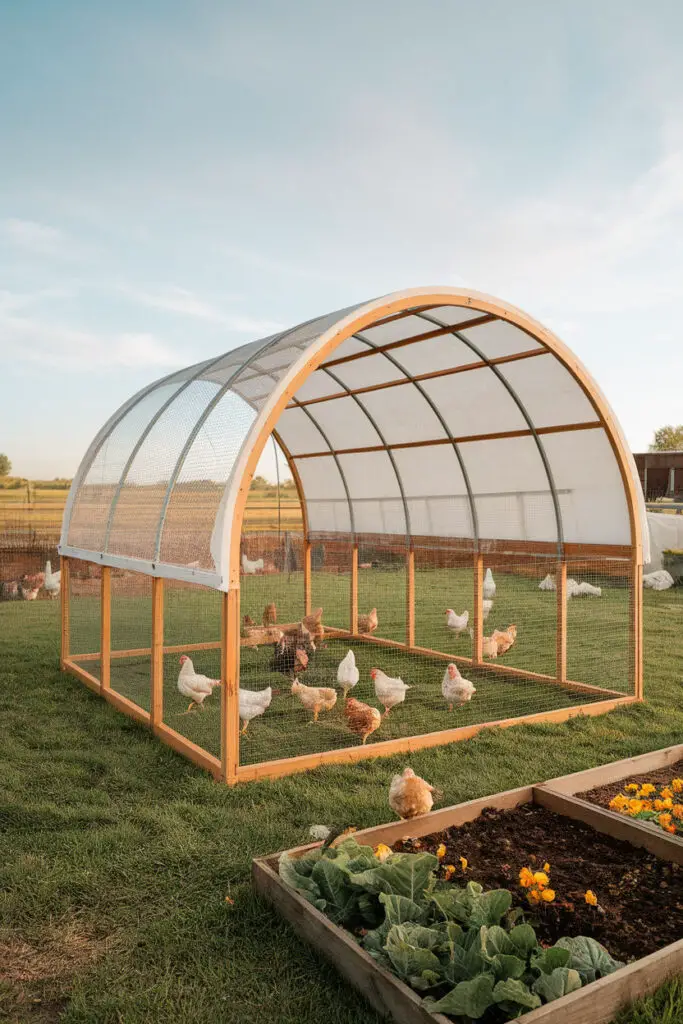
Estimated Cost: $100–$200
Materials: Cattle panels or PVC hoops, tarp, wood base
Skill Level: Intermediate
Pros:
✅ Spacious and breathable
✅ Great for mild to warm climates
✅ Affordable materials
Cons:
❌ Needs reinforcement in wind or snow
❌ Less insulated
Tip: Add shade cloth for summer or a thick tarp for winter.
8. The Tractor Supply Bucket Coop
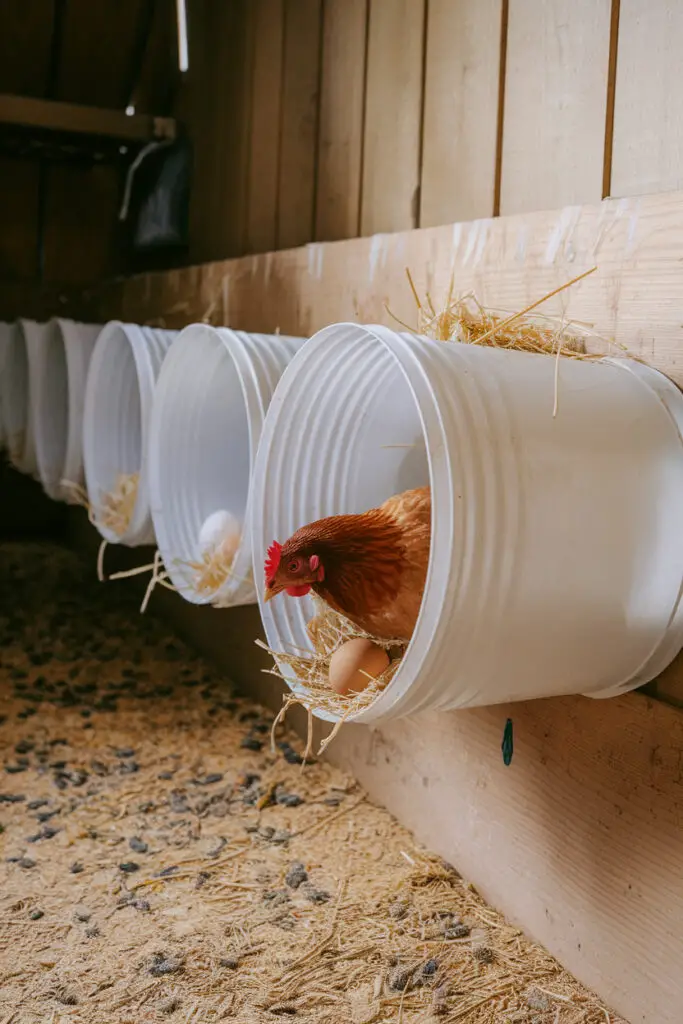
Estimated Cost: $10–$40
Materials: 5-gallon buckets, straw, wooden brackets, screws
Skill Level: Beginner
Pros:
✅ Great as nesting boxes
✅ Super cheap
✅ Easy to replace
Cons:
❌ Not a full coop—just a part of one
❌ Can get hot if placed in direct sun
Tip: Cut an opening on the side of the bucket and lay it on its side. Line with straw and mount in a shady, sheltered spot.
9. Mini Barn-Style Coop
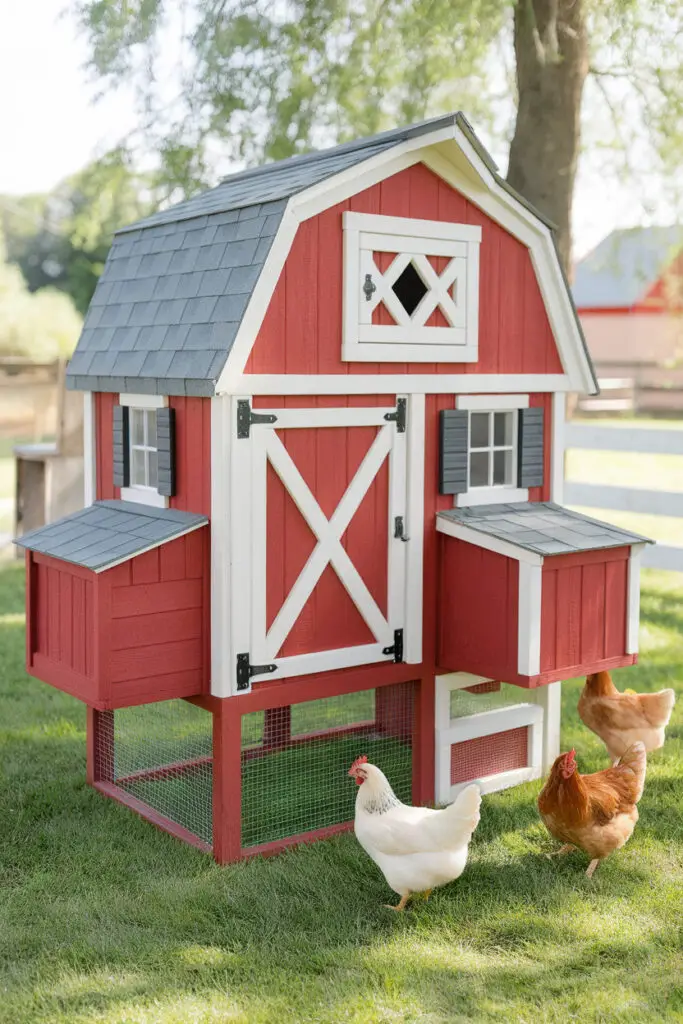
Estimated Cost: $150–$300
Materials: Plywood, 2x4s, tin roof, barn-style trim, wire mesh
Skill Level: Intermediate to advanced
Pros:
✅ Classic farm look
✅ Spacious interior for roosts and nests
✅ Good ventilation with windows
Cons:
❌ Heavier build
❌ Requires a bit of woodworking skill
Tip: Paint it red and white for that iconic mini barn charm. Add a loft for feed storage if you’re feeling ambitious.
10. Raised Bed Chicken Coop Combo
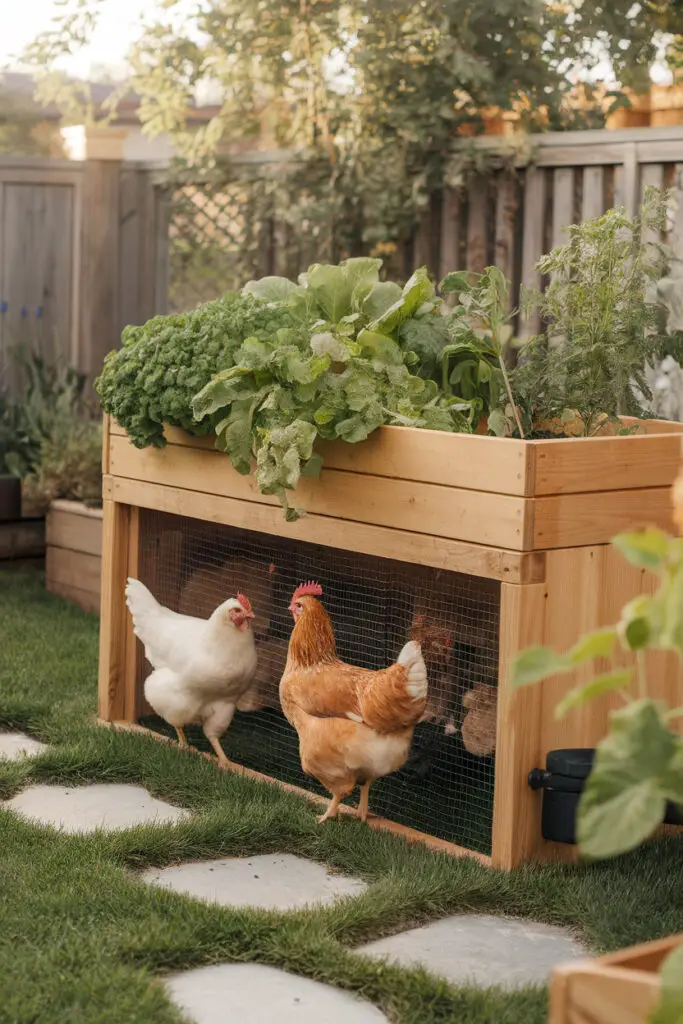
Estimated Cost: $80–$200
Materials: Lumber, chicken wire, corrugated plastic roofing
Skill Level: Intermediate
Pros:
✅ Saves space by combining coop and garden
✅ Chickens fertilize the soil naturally
✅ Great for urban or small yards
Cons:
❌ Needs thoughtful design to separate plants and chickens
❌ Can get messy fast
Tip: Keep your garden bed above the coop or on one end, and plant fast-growing greens your chickens can nibble on.
11. Playhouse Turned Coop (Kid-Friendly Aesthetic)

Estimated Cost: $50–$150
Materials: Old plastic or wood playhouse, roosting bars, nesting boxes
Skill Level: Easy
Pros:
✅ Recycles something your kids outgrew
✅ Super cute and colorful
✅ Weather-resistant if plastic
Cons:
❌ Not predator-proof by default
❌ Limited ventilation unless modified
Tip: Add a picket fence and flower boxes for charm, but don’t forget to reinforce the doors and windows with hardware cloth.
12. Greenhouse Chicken Coop (Warm in Winter)

Estimated Cost: $100–$250
Materials: Clear polycarbonate panels or old windows, wood frame, vents
Skill Level: Intermediate
Pros:
✅ Warm and sunny in winter
✅ Doubles as a greenhouse
✅ Chickens help prevent bugs and fertilize soil
Cons:
❌ Can overheat in summer
❌ Needs good airflow
Tip: Install removable shade cloth or vents for summer, and enjoy fresh greens growing inside with your birds.
13. Wire Spool Coop
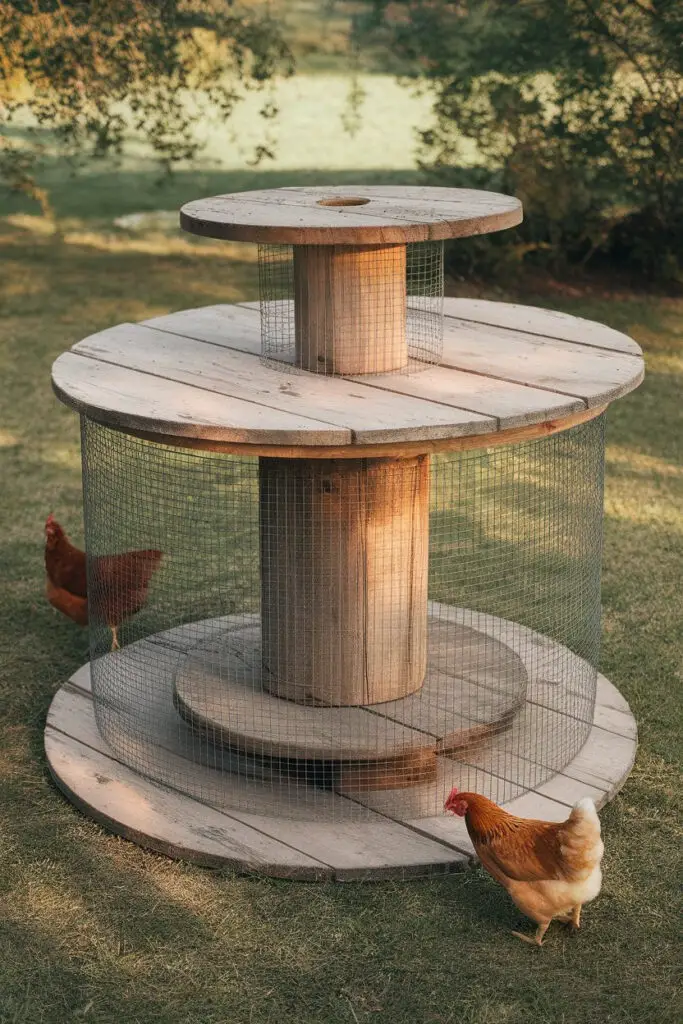
Estimated Cost: $30–$70
Materials: Two large industrial wooden wire spools, hinges, mesh
Skill Level: Intermediate
Pros:
✅ Circular design = unique and compact
✅ Great use of recycled materials
✅ Easy to move if lightweight
Cons:
❌ Harder to insulate
❌ May need a custom ramp or door
Tip: Use one spool as the base and another as the roof, with mesh sides and a door between. Great conversation piece!
14. Old Cabinet Coop (Seriously, It Works)
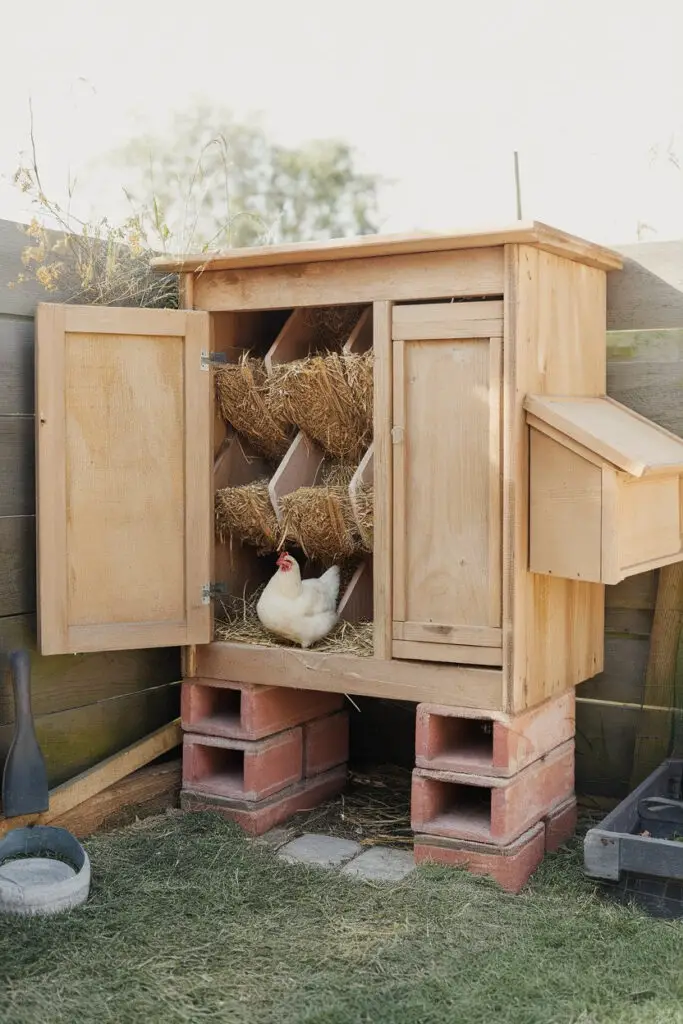
Estimated Cost: $10–$40
Materials: Old wooden cabinet, hinges, mesh, roosting bar
Skill Level: Easy
Pros:
✅ Reuses furniture that might go to the dump
✅ Great for 1–2 hens or as a brooder
✅ Super affordable
Cons:
❌ Limited space
❌ Needs waterproofing
Tip: Line the inside with plastic sheeting or linoleum for easy cleaning. Mount it on blocks to keep it dry.
15. Shipping Crate Coop
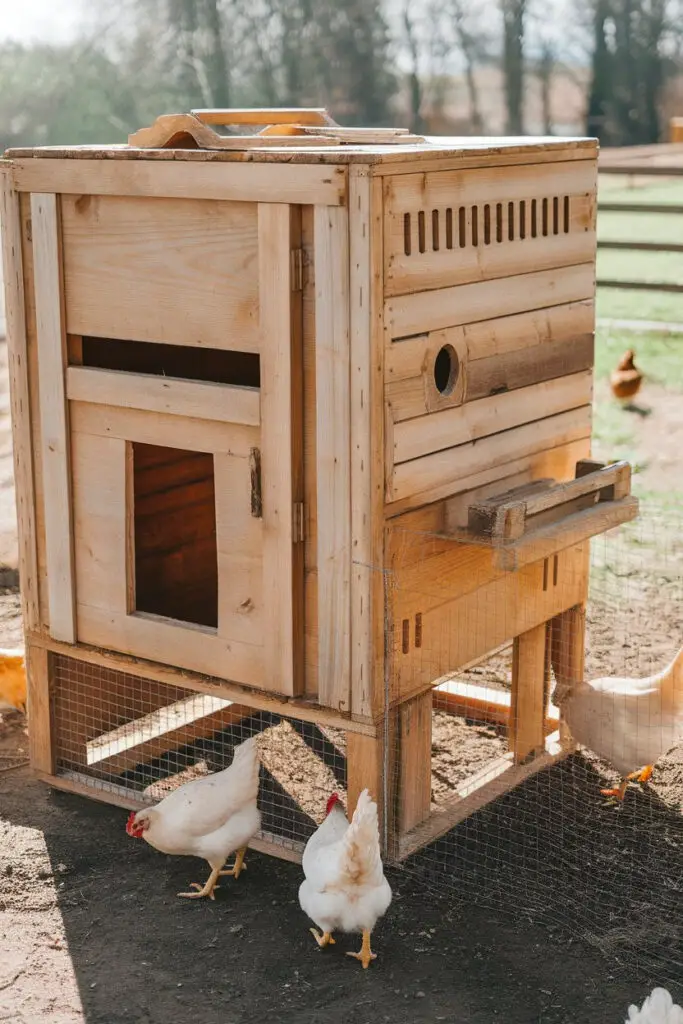
Estimated Cost: $50–$100
Materials: Large wooden shipping crate, mesh, hinges
Skill Level: Beginner to intermediate
Pros:
✅ Strong, ready-made structure
✅ Easy to convert
✅ Weather-resistant with a good roof
Cons:
❌ Heavy to move
❌ Might need sanding and sealing
Tip: Add wheels or handles if you want to move it. Paint it for style points.
16. Swing-Open Roof Coop (Easy Egg Access)
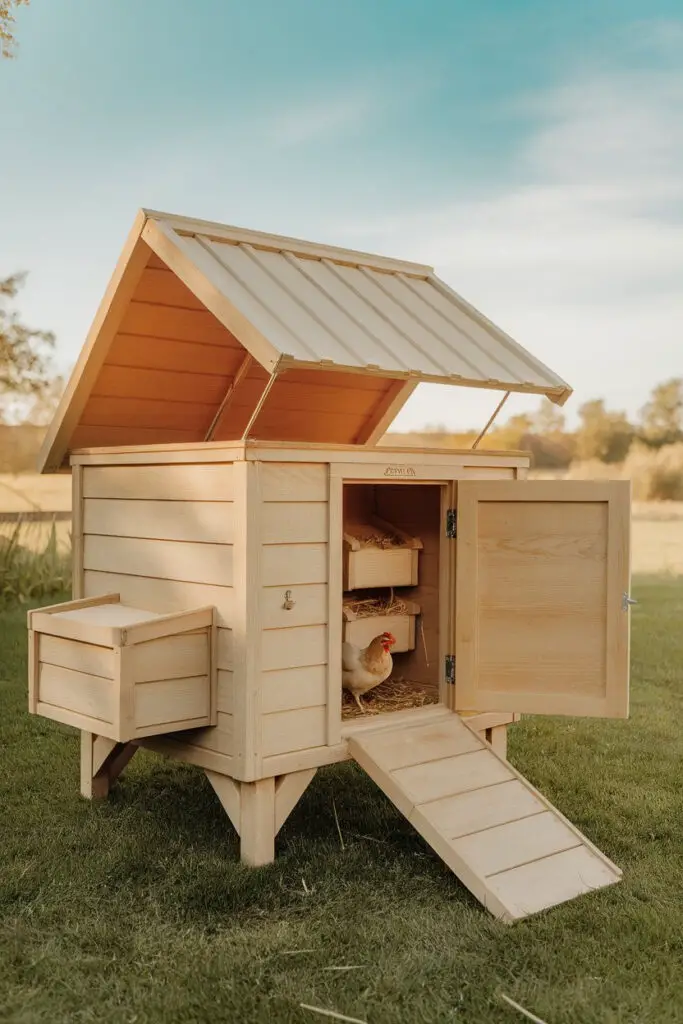
Estimated Cost: $100–$180
Materials: Plywood, hinges, 2x4s, roofing
Skill Level: Intermediate
Pros:
✅ Easy egg collection
✅ Great airflow if roof lifts open
✅ Compact and functional
Cons:
❌ Needs sturdy hinges
❌ Roof can get heavy if not balanced
Tip: Add a support arm or gas struts to keep the roof propped open safely.
Tips for Saving Money on Your Chicken Coop Build
Building a chicken coop doesn’t have to break the bank. With a little creativity and some elbow grease, you can keep costs down while still creating a safe and comfortable home for your hens. Here are some money-saving tips:
Use Recycled or Free Materials
Why buy new when you can repurpose? Many materials like old wood, pallets, or unused furniture can be turned into a great coop. Check around your property or local marketplace for items that people are giving away.
Ask Friends or Neighbors for Leftover Wood or Supplies
Your neighbors might have some leftover building supplies from their own projects, or maybe you can find wood scraps they no longer need. Don’t be shy—ask around! You’d be surprised how many people have extra materials sitting unused.
Join Local DIY or Farming Facebook Groups
Online communities, especially local DIY or farming groups, are full of people willing to trade materials, give away supplies, or offer advice. You might even find some free or discounted materials for your project.
Watch YouTube Tutorials to Avoid Mistakes
DIY is all about learning as you go, but watching experienced builders on YouTube can save you from common mistakes. It’s like having a personal mentor—without the cost! Be sure to watch a few different videos to see different approaches to the same problem.
Plan First, Buy Second
Before you run to the store, sit down and sketch out your design. Measure twice, buy once! Planning ahead will help you avoid impulse buys or realizing you need more materials halfway through the project.
Common Mistakes to Avoid with DIY Chicken Coops
Building your own chicken coop is a rewarding project, but it’s easy to make mistakes, especially if it’s your first time. Here’s what to watch out for to keep your coop safe, functional, and affordable.
Poor Ventilation = Sick Chickens
Chickens need fresh air to stay healthy. If your coop doesn’t have proper ventilation, it can lead to humidity buildup and ammonia from their waste, causing respiratory problems. Make sure to add plenty of vents and windows to allow air to flow freely.
No Predator-Proofing = Heartbreak
Without proper predator-proofing, your chickens are at risk from animals like raccoons, foxes, or even neighborhood dogs. Make sure your coop is well-secured, with sturdy wire mesh, locks, and reinforcements around all openings. Trust us—you don’t want to learn this lesson the hard way.
Skipping Drainage Planning
Water can pool inside your coop, making things muddy and unsanitary for your chickens. Poor drainage can also cause your coop to smell. Plan to have proper drainage by elevating the floor or adding gravel beneath the bedding to help water flow away.
Making Cleaning Too Hard
It’s easy to overlook cleaning access when building your coop, but trust us—it’s a huge deal. Make sure you have a way to easily remove bedding, clean out waste, and collect eggs without crawling through small openings or disassembling parts of the coop. Cleaning should be as easy as possible!
Overcomplicating the Build
It’s tempting to add extra features and complicated designs, but sometimes simpler is better. Overcomplicating the build can lead to higher costs, wasted time, and frustration. Stick to the essentials and build something that’s practical and easy to maintain.

